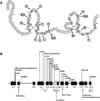Vitamin D receptor mutations in patients with hereditary 1,25-dihydroxyvitamin D-resistant rickets
- PMID: 24246681
- PMCID: PMC3933290
- DOI: 10.1016/j.ymgme.2013.10.014
Vitamin D receptor mutations in patients with hereditary 1,25-dihydroxyvitamin D-resistant rickets
Abstract
Context: Hereditary vitamin D resistant rickets (HVDRR), also known as vitamin D-dependent rickets type II, is an autosomal recessive disorder characterized by the early onset of rickets with hypocalcemia, secondary hyperparathyroidism and hypophosphatemia and is caused by mutations in the vitamin D receptor (VDR) gene. The human gene encoding the VDR is located on chromosome 12 and comprises eight coding exons and seven introns.
Objectives, patients, and methods: We analyzed the VDR gene of 5 previously unreported patients, two from Singapore and one each from Macedonia (former Yugoslav Republic), Saudi Arabia and Turkey. Each patient had clinical and radiographic features of rickets, hypocalcemia, and the 4 cases that had the measurement showed elevated serum concentrations of 1,25-dihydroxyvitamin D (1,25(OH)(2)D). Mutations were re-created in the WT VDR cDNA and examined for 1,25(OH)(2)D(3)-mediated transactivation in COS-7 monkey kidney cells.
Results: Direct sequencing identified four novel mutations and two previously described mutations in the VDR gene. The novel mutations included a missense mutation in exon 3 causing the amino acid change C60W; a missense mutation in exon 4 causing the amino acid change D144N; a missense mutation in exon 7 causing the amino acid change N276Y; and a 2bp deletion in exon 3 5'-splice site (IVS3∆+4-5) leading to a premature stop.
Conclusions: These 4 unique mutations add to the previous 45 mutations identified in the VDR gene in patients with HVDRR.
Keywords: HVDRR; Hypocalcemia; Mutations; Rickets; Vitamin D; Vitamin D receptor.
© 2013.
Figures


References
-
- Feldman D, Pike JW, Adams JS. Vitamin D. Third Edition. San Diego: Elsiever; 2011. pp. 1–2144.
-
- Haussler MR, Whitfield GK, Kaneko I, Haussler CA, Hsieh D, Hsieh JC, Jurutka PW. Molecular mechanisms of vitamin D action. Calcif Tissue Int. 2013;92:77–98. - PubMed
-
- Malloy PJ, Pike JW, Feldman D. The vitamin D receptor and the syndrome of hereditary 1,25-dihydroxyvitamin D-resistant rickets. Endocr. Rev. 1999;20:156–188. - PubMed
-
- Malloy PJ, Tiosano D, Feldman D. Hereditary 1,25-dihydroxyvitamin D resistant rickets. In: Feldman D, Pike JW, Adams JS, editors. Vitamin D. Third Edition. San Diego: Elsevier; 2011. pp. 1197–1232.
Publication types
MeSH terms
Substances
Grants and funding
LinkOut - more resources
Full Text Sources
Other Literature Sources
Medical

